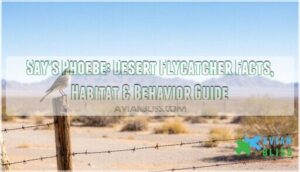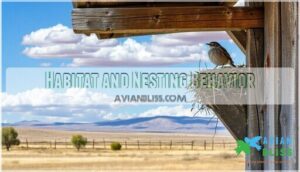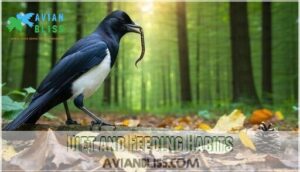This site is supported by our readers. We may earn a commission, at no cost to you, if you purchase through links.

This 7-inch desert flycatcher sports gray-brown upperparts with a pale cinnamon belly and distinctive black tail. Unlike other flycatchers, it lacks bright patches or wingbars.
You’ll spot them perched upright in open, dry habitats across western North America, from prairies to desert edges. They’re excellent hunters, using sally-striking techniques to catch beetles, flies, and grasshoppers.
Northern populations migrate south for winter, while southern birds stay put year-round. Their mud-free nests made of grass and moss often appear on buildings, cliffs, and bridges.
These adaptable birds reveal fascinating secrets about desert survival. They are notable for their ability to thrive in harsh environments, making them a subject of interest for studying wildlife adaptation and ecological balance.
Table Of Contents
- Key Takeaways
- Identification of Say’s Phoebe
- Habitat and Nesting Behavior
- Reproduction and Lifespan
- Diet and Feeding Habits
- Migration Patterns and Seasonal Occurrence
- Frequently Asked Questions (FAQs)
- Where does the say’s Phoebe live?
- Why is it called a Phoebe?
- What kind of bird is say’s Phoebe?
- What does say’s Phoebe look like?
- How does say’s Phoebe watch for insects?
- Do phoebes have parents?
- Do says Phoebes mate for life?
- Where do say’s Phoebes nest?
- What are some interesting facts about Say’s phoebe?
- What is the difference between a black Phoebe and a says phoebe?
- Conclusion
Key Takeaways
- You’ll recognize Say’s Phoebe by its barrel-chested build, gray-brown upperparts, cinnamon belly, and distinctive black tail that it frequently flicks – making identification easy in open western habitats.
- These adaptable birds thrive in harsh desert conditions from Alaska to Mexico, using sally-striking hunting techniques to catch insects while perched upright on low shrubs, cliffs, and human structures.
- Say’s Phoebes build mud-free nests from grass and moss on buildings, bridges, and rocky ledges, typically raising 1-2 broods per year with 3-7 white eggs that females incubate for 12-18 days.
- Northern populations migrate south for winter while southern birds remain year-round residents, demonstrating flexible migration patterns that help them maintain the broadest latitudinal range of any flycatcher species.
Identification of Say’s Phoebe
When you spot a Say’s Phoebe, you’ll notice its distinctive barrel-chested silhouette and squared-off head that sets it apart from other flycatchers.
This desert dweller measures about 7 inches long with a 13-inch wingspan, falling between a sparrow and robin in size comparison. The bird’s field marks include gray-brown upperparts, a pale cinnamon belly, and a striking black tail that it frequently flicks.
Unlike flashier species, Say’s Phoebe sports subtle plumage variations without bright patches or wingbars. Juvenile ID becomes easier when you recognize their buffy wingbars and yellower gape.
The bird’s vocalizations feature a clear "pee-ur" whistle that sounds almost melancholy. Bird identification guides emphasize watching for its upright perching posture and tail-pumping behavior.
These bird characteristics make Say’s Phoebe stand out in any bird field guide focused on western species. In contrast, the closely related Eastern Phoebe wags its tail more gently.
Habitat and Nesting Behavior
Say’s Phoebes choose open, dry habitats across western North America for their versatile nesting behavior.
These desert masters adapt their open-country lifestyle to thrive where others struggle
These adaptable birds make smart habitat selection choices that support successful breeding:
- Nest Site preferences: Buildings, cliffs, caves, and bridges provide ideal locations
- Nesting Materials: Grasses, moss, hair, and cocoons create sturdy structures without mud
- Territory Size: Open country from prairies to desert edges offers ample hunting grounds
- Human Impact: Ranch buildings and structures actually benefit these resourceful birds
Their bird nesting habits differ from other flycatchers since they avoid mud construction entirely.
This nest construction approach helps Says Phoebe avoid cowbird parasitism while thriving in human-modified landscapes.
Reproduction and Lifespan
You’ll find that Say’s Phoebes have fascinating reproductive habits that help them thrive in harsh desert environments.
These resilient birds typically raise one to two broods per year, with females handling most of the parenting duties while males focus on territory defense.
Say’s Phoebes master the art of desert parenting through exceptional teamwork and unwavering dedication.
Breeding Season
Timing matters when you’re watching for breeding activity in Say’s Phoebes.
These desert flycatchers begin their nesting season in late March and continue through August.
Peak egg-laying varies by elevation from early April to late May.
You’ll find active nests between 300 to 1800 meters elevation in open country.
Most pairs successfully raise two broods annually, with breeding success linked to their smart nest site selection in protected rocky ledges and human structures.
They typically build nests using forbs, grasses, and moss.
Egg-laying and Incubation
Egg-laying marks a critical phase when Say’s Phoebes demonstrate remarkable dedication.
Female incubation lasts 12-18 days while she carefully tends her clutch size of 3-7 pure white eggs.
Here’s what makes this process fascinating:
- Clutch Size averages 4-5 eggs per nest
- Egg Coloration appears unmarked white, occasionally with reddish spots
- Incubation Period spans roughly two weeks
- Parental Roles place full responsibility on females
- Hatching Success produces naked, eyes-closed nestlings
The female’s unwavering commitment guarantees maximal broods development.
Bird enthusiasts may need to acquire proper incubation equipment for artificial incubation.
Nesting Behavior
Through nesting behavior, Say’s Phoebes demonstrate remarkable adaptability in their choice of nest locations.
These resourceful birds construct open-cup nests using plant materials, hair, and spider silk as primary bird nesting materials. You can even find pre-made nesting materials to help them out.
- Nest location preferences include rocky shelves, undercut banks, and man-made structures like abandoned buildings
- Nest construction occurs from mid-March in Texas to late May in Alaska, varying with elevation
- Bird nesting sites range from 300 to 1800 meters in sparsely vegetated desert and grassland habitats
Lifespan in The Wild
In the wild, Say’s Phoebes typically live 7-8 years, which is shorter than their eastern cousins who reach 10 years.
These hardy desert birds pack impressive longevity into lives spent mastering harsh western landscapes
Wild longevity depends on surviving threats to survival like predators, weather, and habitat loss.
Annual mortality affects population dynamics substantially, and maximum age records help scientists understand bird aging patterns.
You can find products related online to learn more about these resilient desert flycatchers and develop bird conservation status assessments.
Diet and Feeding Habits
You’ll witness Say’s Phoebe’s impressive insect consumption as these skilled hunters use diverse hunting strategies.
Their foraging behavior involves three main techniques:
- Sally-striking – darting from perches to snatch flying insects mid-air
- Hover-gleaning – briefly hovering to pluck prey from vegetation surfaces
- Ground-pouncing – dropping down to capture terrestrial insects
Their insectivorous diet shows remarkable prey variety, including beetles, grasshoppers, flies, and bees.
Say’s Phoebes are commonly found in open-country habitats.
These dietary adaptations help nestlings thrive while parents demonstrate exceptional feeding behavior throughout breeding seasons.
Migration Patterns and Seasonal Occurrence
Say’s Phoebes showcase fascinating migration patterns that vary across their vast range. These adaptable bird migration specialists don’t follow a single playbook. Northern populations migrate south for winter while southern birds stay put year-round.
Spring arrival begins in March as breeding birds return to northern territories. Peak breeding distribution spans May through August across western regions. Fall departure starts in September when northern birds head to their winter range in the southwestern United States and Mexico.
Migration routes follow mountain corridors and desert pathways. Bird migration patterns reveal Say’s Phoebes travel shorter distances than many flycatchers. Some populations move just a few hundred miles while others journey from Alaska to Mexico. Understanding how they navigate requires examining their celestial navigation skills.
| Season | Northern Range | Southern Range |
|---|---|---|
| Spring | Breeding begins | Year-round residents |
| Summer | Peak breeding | Continued breeding |
| Fall | Migration starts | Stable populations |
| Winter | Southern wintering | Permanent residents |
| Bird season | Alaska to Canada | Texas to Mexico |
This flexible approach helps them thrive across North America’s most diverse landscapes.
Frequently Asked Questions (FAQs)
Where does the say’s Phoebe live?
Like a wandering nomad of the west, you’ll find Say’s Phoebes across dry, open country from Alaska to Mexico.
They thrive in sagebrush plains, canyons, badlands, and ranch areas throughout western North America.
Why is it called a Phoebe?
You’ll discover the name comes from the Roman moon-goddess Diana, but it may also have been chosen to imitate the bird’s call.
The Greek origin means "bright, pure," perfectly matching this cheerful bird’s sunny personality.
What kind of bird is say’s Phoebe?
Say’s Phoebe is absolutely the most adaptable flycatcher you’ll encounter in western North America’s dry landscapes.
This gray-brown bird with its distinctive black tail hunts insects from low perches across prairies, canyons, and badlands, making it a notable species in these areas due to its adaptable nature.
What does say’s Phoebe look like?
You’ll recognize this gray-brown flycatcher by its distinctive black tail that it frequently flicks upward, peachy-cinnamon belly, and upright perching posture on low shrubs.
How does say’s Phoebe watch for insects?
Though you might expect constant motion, phoebes actually use patient perch-and-wait tactics.
They sit motionless on low shrubs or rocks, then dart out to snatch flying insects mid-air before returning to their lookout post.
Do phoebes have parents?
Yes, phoebes have parents like all birds.
Adult Say’s Phoebes care for their young through incubation, feeding, and protection until the juveniles fledge and become independent enough to survive on their own.
Do says Phoebes mate for life?
Like Romeo and Juliet’s brief romance, most flycatcher relationships don’t last forever.
Say’s Phoebes typically don’t mate for life, though some pairs might reunite if they’re both successful survivors, as they’ll find new partners each breeding season.
Where do say’s Phoebes nest?
You’ll find Say’s Phoebes nesting on man-made structures like building eaves, bridges, and ranch outbuildings.
They also use natural cliff ledges, canyon walls, and rock overhangs in their dry western habitats.
What are some interesting facts about Say’s phoebe?
Say’s Phoebe is nature’s marathon runner, boasting the broadest latitudinal range of any flycatcher.
You’ll find them from Alaska’s arctic tundra to Mexico, making them uniquely cold-hardy insect-eaters that survive harsh conditions.
What is the difference between a black Phoebe and a says phoebe?
Black Phoebes have solid black heads and backs with white bellies.
Say’s Phoebes sport gray-brown upperparts with cinnamon-colored bellies.
You’ll spot Black Phoebes near water; Say’s Phoebes prefer dry, open country.
Conclusion
Research shows that Say’s phoebes can live up to 12 years in the wild despite harsh desert conditions.
Understanding the Say’s phoebe reveals nature’s remarkable adaptability in extreme environments.
You’ve learned how these hardy flycatchers survive scorching temperatures and scarce water sources through specialized behaviors and physical adaptations.
Their success demonstrates that wildlife can thrive when equipped with proper survival strategies.
Observing Say’s phoebes offers valuable insights into desert ecology and conservation efforts.








